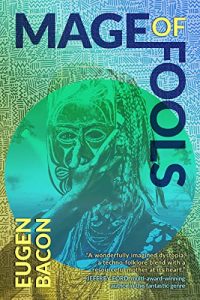Paul Di Filippo reviews James P. Blaylock
 James Blaylock’s career is nearly exactly the same length as my own. Although we’ve had hardly any informal contacts down the decades, I’ve nonetheless always felt a secret kinship that extends beyond my love of his work. After all, we both debuted in the pages of Unearth magazine, that vehicle of sainted memory whose mission statement was to seek out and foster unpublished writers. I had my story in issue number one, while Blaylock showed up in number three (Summer 1977). And I also fancy that we share this sobering authorial description from Blaylock’s entry in The Science Fiction Encyclopedia: “It was by now clear that Blaylock’s talent was strong, but sufficiently weird and literary as to be unlikely to attract a mass-market readership.” *Sigh* In any case, 2012 marks his thirty-fifth year as a professional. Hard to believe, for me and him both.
James Blaylock’s career is nearly exactly the same length as my own. Although we’ve had hardly any informal contacts down the decades, I’ve nonetheless always felt a secret kinship that extends beyond my love of his work. After all, we both debuted in the pages of Unearth magazine, that vehicle of sainted memory whose mission statement was to seek out and foster unpublished writers. I had my story in issue number one, while Blaylock showed up in number three (Summer 1977). And I also fancy that we share this sobering authorial description from Blaylock’s entry in The Science Fiction Encyclopedia: “It was by now clear that Blaylock’s talent was strong, but sufficiently weird and literary as to be unlikely to attract a mass-market readership.” *Sigh* In any case, 2012 marks his thirty-fifth year as a professional. Hard to believe, for me and him both.
Blaylock has primarily worked in two modes all that time: steampunk, and urban fantasy. In the latter mode, his work has been alternately comic, tragic, or a mix. Understand that by urban fantasy I do not reference the current, rather debased and trite state of the art subsumed under that term. Instead, I refer to the brilliant classic lineage: Thorne Smith and Fritz Leiber and de Camp & Pratt; John Crowley and Charles de Lint; Patrick McGrath and Nicholas Christopher. Contemporary naturalistic settings and characters with off-kilter fantastical elements.
After some recent books that explored his steampunk interests, Blaylock now returns to urban fantasy, producing a thrill-filled novel blended of whimsy and danger, absurdity and eternal wisdom. Specifically, he’s back in the world that we first encountered in 1984’s The Digging Leviathan: contemporary oddball California (and beyond), where the elite members of the Guild of St. George battle nefariousness in all its manifestations.
Three new members of the heroic Guild—well, honorary members at least—are the cousins Brendan (age ten), Kathleen (age eleven, very close to twelve), and Perry (age thirteen). They reside with their “Uncle Hedge,” John Toliver Hedgepeth, and a hybrid bulldog named Hasbro, in Caspar, CA. Kathleen, a budding cryptozoologist, is our narrator, and a fine job she does, getting down all the weird action in crystal-clear paragraphs of simple but vividly colorful writing; giving her salty opinions liberally; characterizing friends and foes with insight; and generally speculating cleverly about The Meaning of It All.
The meaning and relevance of the title, by the way? Not the actual prehistoric beast, but a huge old car so christened, making this book one of the few fantasies named after an automobile, the most famous such case being Chitty-Chitty-Bang-Bang, which happened to have been written for Ian Fleming’s son, who was named—wait for it—Caspar! This circular allusiveness is in line with Blaylock’s formal declaration up front, which sings the praises of formative tales by E. Nesbit, ERB, Jules Verne, and other classic writers. His triumph resides in making his own work fresh and unique, not a mere pastiche, while still paying glorious homage.
Insidious events commence with the appearance in Caspar of several intimidating personages. First there’s Ms. Peckworthy, a social worker who fastidiously wants to remove the kids from Uncle Hedge’s care. Then, more dangerously, comes the abrupt and poisonous Wheyface the Creeper, intent on stealing valuable documents and artifacts in the care of the Guild. Thirdly we have Lala Peach, ostensibly a friend—part of the well-known amphibian Peach clan, you see—but bent on her own objectives. The kids face several trials at home which soon spiral into larger missions. Before you can say “Into the Zeuglodon!”, they find themselves adrift off the Grand Banks where the malign Dr. Hilario Frosticos (see Digging Leviathan and elsewhere) awaits. Then it’s on to England, where subterranean exploits inveigle.
In allowing young Kathleen to narrate in the first-person, Blaylock plays an adept’s game, with the narrative always partway suspended between YA and adult fiction. But he does the job as deftly as Madeleine L’Engle, Edward Eager, or John Bellairs, and readers of all ages will find the tale rewarding. Kathleen, after all, is probably wiser than most of her audience:
Something’s being silly sometimes doesn’t matter. You’re crying over something and someone says, ‘Oh, don’t be silly,’ and it doesn’t help at all, even if it’s right. Being silly that way isn’t a matter of wanting to. It’s just something that happens. You wish it didn’t, but it did, and that’s that.
If only we could all have such a mature perspective on our mistakes and griefs.
What Blaylock has done here, on one excellent level, is to construct a pure Carl Barks adventure. Uncle Hedge stands in more competently for Unca Donald, with the cousins doing a tolerable Huey, Louie and Dewey. But on another, arguably higher plane, he’s shown that the innocent archetypes of youthful adventuring can fully withstand the larger horrors of the twenty-first century and all our cynicism and decadence.







